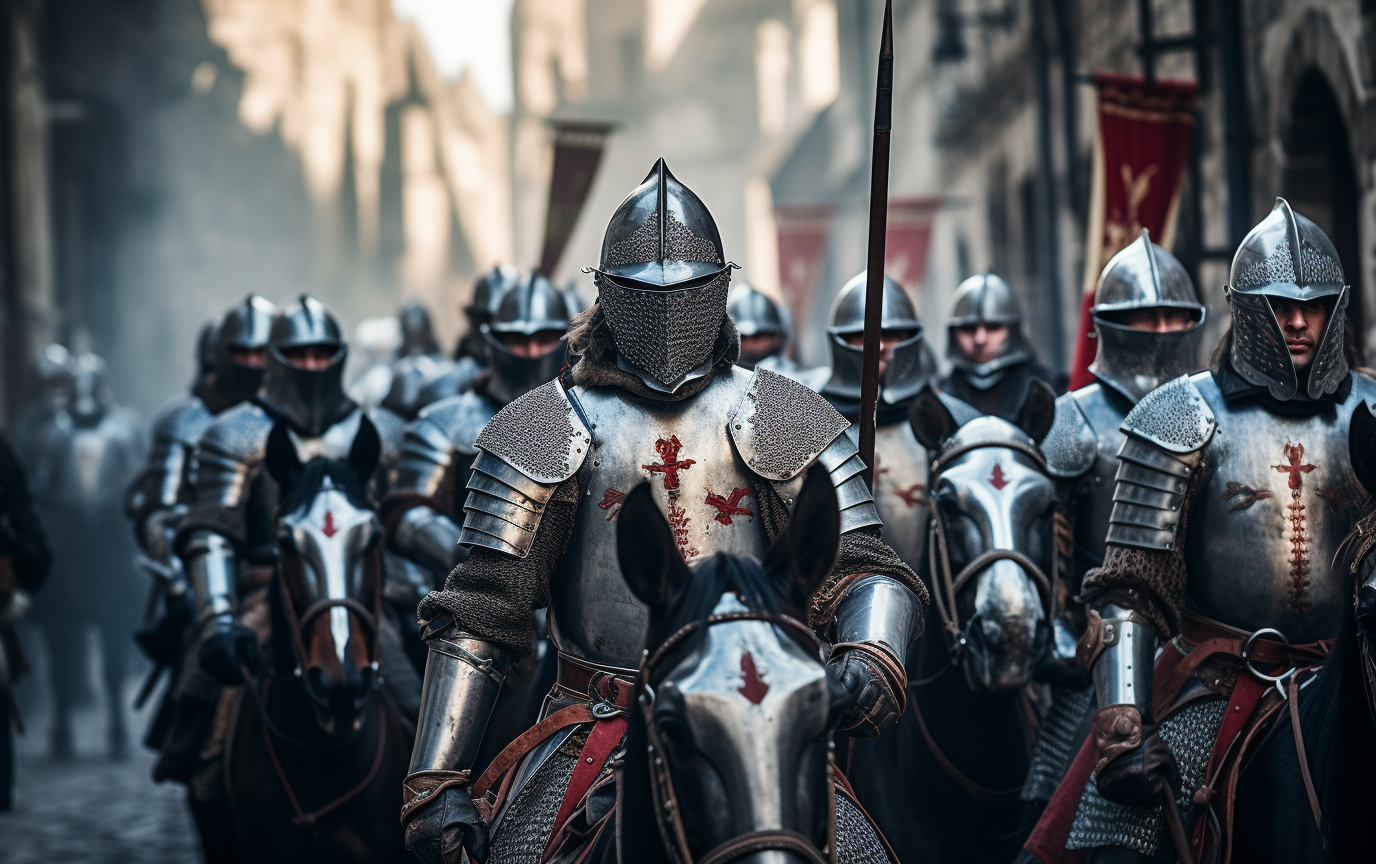
Embarking on the path to knighthood in medieval times was no ordinary feat.
It involved a rigorous journey that started in childhood and required unwavering dedication.
In this exploration, we delve into the intricate process of becoming a knight, from the early days as a page to the grandeur of the knighting ceremony.
Let’s unravel the fascinating world of medieval chivalry.
Fun Facts About Medieval Knights
The Path to Knighthood

Becoming a knight in medieval times was not a quick accomplishment but rather a gradual and comprehensive process.
Noblemen embarked on a journey that started in their early years and involved rigorous training in various aspects of chivalry.
- Read also: Armour of an English Medieval Knight
- Read also: Exploring the British Medieval Era
Fact 1: A lengthy journey to knighthood
Noble boys, often from a young age, began their journey towards knighthood as pages.
During this initial phase, they received instruction in essential skills such as manners, etiquette, horsemanship, and weaponry.
This foundational training aimed to instill a sense of discipline and cultivate the fundamental skills required for a life of chivalry.
Fact 2: The Squire’s Apprenticeship
Around the age of 14, promising candidates progressed to the next stage of their training: squirehood.
This phase involved a more intense apprenticeship, where young men accompanied experienced knights on their quests.
They actively participated in warfare, gaining practical experience and firsthand exposure to the noble code of conduct.
The squire’s role was not only to learn but also to assist the knight in various aspects of their duties.
Fact 3: The knighting ceremony
The pinnacle of a nobleman’s journey towards becoming a knight was the knighting ceremony.
In this solemn event, the aspiring knight knelt before a lord or monarch.
A symbolic touch of the sword on their shoulders marked the formal transition into the elite ranks of knighthood.
This ceremony signified the culmination of years of training and preparation, transforming the individual into a fully-fledged knight ready to uphold the principles of chivalry.
Life as a Medieval Knight

The medieval knight, beyond being a formidable warrior, played a diverse and pivotal role in the socio-political landscape of the time.
From the battlefield to the realm of chivalry and beyond, their lives were marked by a unique blend of martial prowess and unexpected versatility.
Fact 4: Knights as warriors
At the core of a knight’s identity was their prowess as warriors.
Mounted on horseback, knights dedicated themselves to defending lands, engaging in tournaments for both entertainment and showcasing their skills.
Their responsibilities extended to the protection of castles and active participation in battles, contributing significantly to the defense and expansion of their kingdoms.
Fact 5: Chivalry: The code of conduct
The character of a knight was shaped by the strict adherence to chivalry, a code of virtues that defined their conduct.
Paramount among these virtues were courage, honor, justice, and loyalty.
Knights were not only skilled fighters but also exemplars of courtesy and respect, particularly towards women and the vulnerable.
Chivalry served as a moral compass, guiding knights in their interactions both on and off the battlefield.
Fact 6: Knights Beyond Warfare
The life of a medieval knight transcended the boundaries of warfare.
While some knights were strategic advisors, providing counsel to rulers, others took on administrative roles, managing lands and resources.
Surprisingly, knights were not confined solely to martial pursuits; some delved into artistic or literary endeavors, showcasing a more nuanced and multifaceted aspect of their lives.
This unexpected diversity highlighted the adaptability and varied skill sets of these noble warriors.
The Enduring Legacy of Knights

The legacy of knights extends far beyond the confines of the Middle Ages, leaving an indelible mark on our collective imagination.
As the era of knights waned, their enduring influence continued to shape literature, film, and the timeless principles of chivalry.
Fact 7: The decline of knights
With the progression of the Middle Ages, the prominence of knights began to fade.
Advances in weaponry rendered the traditional heavy armor less effective, marking the decline of the era of knights.
However, even as their practical utility diminished, the symbolic image of the knight endured, representing ideals of bravery, honor, and chivalry that continue to captivate our collective consciousness.
Fact 8: Knights in literature and film
Knights have become immortalized in literature and film, seamlessly transitioning from medieval romances to modern fantasy epics.
These portrayals, ranging from the chivalric tales of yore to contemporary interpretations, have played a crucial role in shaping our understanding of knights and their historical significance.
The enduring appeal of these figures speaks to the timeless allure of the noble and heroic ideals they embody.
Fact 9: The legacy of chivalry
While the era of knights may have come to an end, the legacy of chivalry persists.
The principles of courage, honor, justice, and loyalty, central to the knightly code, have transcended the confines of time and adapted to modern sensibilities.
The enduring resonance of these principles serves as a testament to the lasting impact of knights, inspiring us with their dedication, commitment to service, and unwavering pursuit of noble ideals.
- Read also: Exploring Medieval Era Facts and Beyond
- Read also: Medieval Era Inventions
Conclusion
In this exploration of knighthood’s journey and the legacy of chivalry, we unearth more than a historical account – we discover a timeless inspiration.
The ideals that defined knights of old continue to echo in the corridors of our modern consciousness, shaping our perception of honor, fueling our courage, and beckoning us towards the pursuit of noble virtues.
As we reflect on this enduring legacy, we recognize that the essence of knighthood is not confined to the pages of history but lives on as a source of perennial inspiration for generations to come.
FAQs
The journey to knighthood was lengthy, starting as a page at around 7 or 8 and culminating in a knighting ceremony, typically around the age of 21.
Knights played diverse roles, serving as advisors, administrators, and even pursuing artistic or literary endeavors.
Advances in weaponry and tactics made heavy armor less effective, contributing to the decline of knights in the later Middle Ages.



